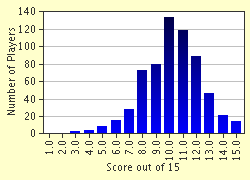Quiz Answer Key and Fun Facts
1. "Dictionary.com" defines blockbuster as a film "that sustains widespread popularity and achieves enormous sales". I define "super blockbuster" as a movie whose gross US revenues exceed the gross domestic product of a small country - arbitrarily set at $500,000,000 (adjusted for inflation based on 2005 ticket prices). Only 23 movies achieved this in the twentieth century.
In 1937, one of the giants of filmmaking produced the first film to earn the equivalent of more than $500,000,000 (adjusted for inflation). The shortest of the 23 super blockbusters at 79 minutes, the movie received only one Academy Award nomination in 1938. However, in 1939, the film was recognized as "a significant screen innovation, which has charmed millions and pioneered a great new entertainment field." The person responsible for the film received one full-sized Oscar and seven little Oscars in recognition of this. Which revolutionary filmmaker received the special award?
2. MGM released the second of the 20th century's super blockbusters in 1939. The Motion Picture Academy showered it with thirteen Oscar nominations and eight Oscars, including Best Picture and Best Director. The US public showered it with the inflation-adjusted equivalent of $1.3 billion dollars in revenue, making it the highest grossing film of the 20th century. Still, Time Magazine left it off its list of the "All-Time 100 Movies". But speaking as a great fan of this wondrous movie, "Frankly, I don't give a ..."
Which film was the inflation-adjusted, highest grossing film of the 20th century?
3. In 1941, Walt Disney's "Fantasia" became the third super blockbuster film, netting an inflation-corrected $531 million dollars. Afterwards, Hollywood seemed to lose its knack for producing mega blockbusters. Finally, fifteen years later in 1956, "The Ten Commandments" was released and ultimately became the fifth highest grossing film of the twentieth century. Six years later a second epic, "Ben-Hur", became a super blockbuster. "The Ten Commandments" and "Ben-Hur" had much in common. Which of the following was NOT a feature of both?
4. The first six Hollywood super blockbusters (films grossing more than $500,000,000 adjusted for inflation) alternated between live action movies and animated films. In 1964, Disney released the seventh super blockbuster, "Mary Poppins". How could "Mary Poppins", be characterized?
5. In 1965, Julie Andrews became the only star to be the leading actress in super blockbusters in consecutive years. Listed below are the four highest grossing non-animated musicals of the twentieth century, but only the one starring Julie Andrews earned more than ½ billion dollars (adjusted for inflation). Which of them was it?
6. The Motion Picture Association of America (MPAA) ratings were instituted on November 1, 1968. All nine of the earlier super blockbusters (movies earning more than an inflation-adjusted 1/2 billion dollars) have since received ratings except "The Ten Commandments". All but two received the "lowest" "G" rating. Which of the following received the "highest", which is to say, most adult rating among the super blockbusters released before 1968?
7. An MPAA rating of "R" indicates that children under 17 may not attend a movie unless accompanied by an adult. One might think that an R rating would significantly hamper a film's box office potential since the audience would be "restricted". This should be a particularly significant factor in producing a super blockbuster since exceptional attendance levels would be needed to generate exceptional income. The first two super blockbusters after the MPAA ratings were instituted were "The Godfather" and "The Exorcist". Which of them had an R rating?
8. All of the movies of the twentieth century that have earned more than $500,000,000 adjusted for inflation were released from 1937 to 1997, ten in the first half of this period, thirteen in the second. Which of the following is NOT a true difference between the movies in the two periods?
9. In 1975, "Jaws" became the second horror/suspense film to gross over ½ billion dollars (adjusted for inflation). Director Steven Spielberg directed three other films that became super blockbusters in the 20th century. Which of the following is NOT one of them?
10. In 1977, Twentieth Century Fox released a seminal film in a genre that had not previously produced a super blockbuster. Grossing over one billion inflation-adjusted dollars, it became the second highest grossing picture of the twentieth century. But, did George Lucas earn a Best Director's Oscar for "Star Wars"?
11. Four "Star Wars" films were released in the twentieth century: "Star Wars", "The Empire Strikes Back", "Return of the Jedi" and "Star Wars: Episode I - The Phantom Menace". In addition to the original "Star Wars", which of these earned more than ½ billion dollars (adjusted for inflation) qualifying them to be super blockbusters?
12. Between them, Spielberg and Lucas have been involved in eight super blockbusters (films with revenues exceeding ½ billion inflation adjusted 2005 dollars). Beginning with "Jaws" in 1975, the two directors produced the next seven super blockbusters. Which of the following films was the last of these?
13. Finally, after seven consecutive super blockbusters involving either Spielberg or Lucas, Robert Zemeckis directed a movie that (barely) earned $500,000,000 US dollars (adjusted for inflation). Which of the following films did Zemeckis direct?
14. Not every genre of film seems suited to produce a super blockbuster. In the 20th century, which of the following genres failed to produce a film that grossed ½ billion dollars at the box office (adjusted for inflation)?
15. The 20th century's final super blockbuster could be considered an historical romance as well as a disaster film. Some might even consider it an epic. The name of the film well describes the $821,413,700 this film brought in at the box office. What is the name of this 1997 film that featured Leonardo DiCaprio and Kate Winslet?
Source: Author
uglybird
This quiz was reviewed by FunTrivia editor
Nannanut before going online.
Any errors found in FunTrivia content are routinely corrected through our feedback system.

